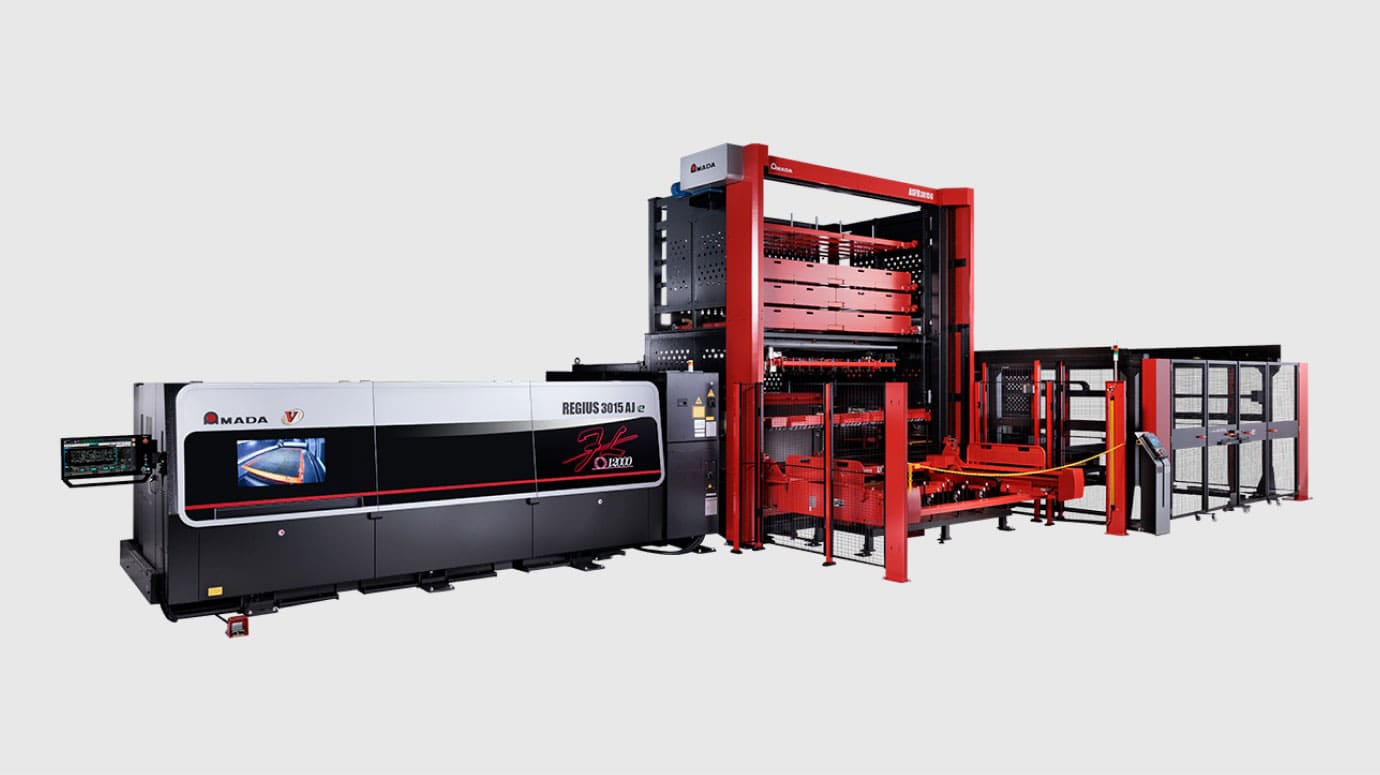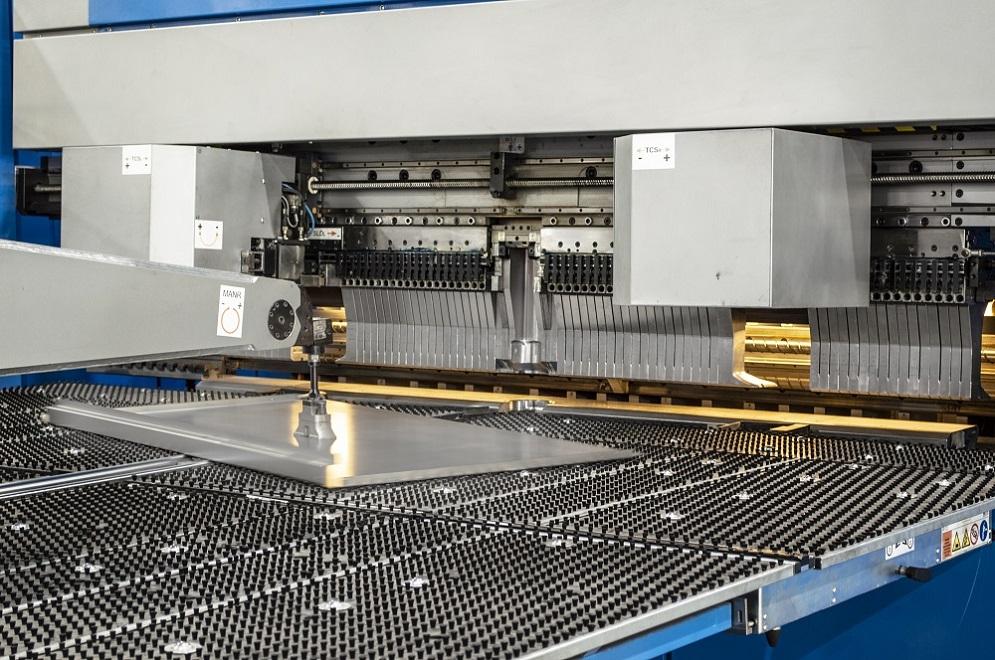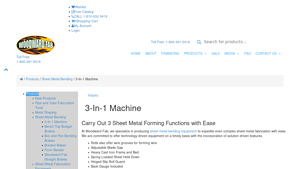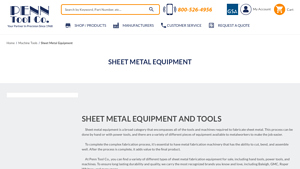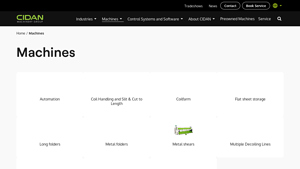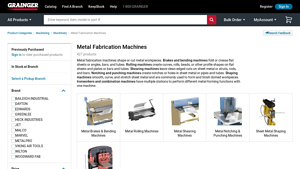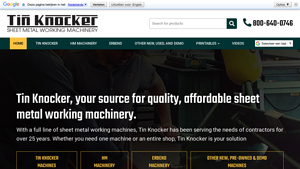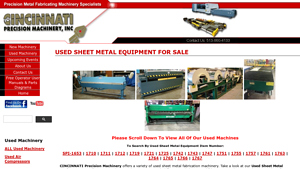Sheet Metal Fabrication Machines Guide: Type, Cost, Top List…
Introduction: Navigating the Global Market for sheet metal fabrication machines
Navigating the intricate landscape of sheet metal fabrication machines can be a daunting task for international B2B buyers. The challenge lies not only in sourcing high-quality equipment that meets specific manufacturing needs but also in ensuring that these machines are adaptable to diverse applications across various industries. This comprehensive guide serves as an essential resource, detailing the types of sheet metal fabrication machines available, their applications, and crucial factors to consider when making a purchasing decision.
With a focus on critical components such as supplier vetting, pricing strategies, and regional market insights, this guide empowers buyers from Africa, South America, the Middle East, and Europe—specifically countries like Brazil and Germany—to make informed decisions. By understanding the nuances of different machine types, including metal shearing machines, sheet metal brakes, and slip roll machines, buyers can streamline their procurement processes and enhance operational efficiency.
Moreover, this guide provides actionable insights into evaluating suppliers based on quality standards, customer support, and after-sales services. In an increasingly competitive global market, leveraging this knowledge will not only minimize risks but also ensure that investments in sheet metal fabrication machines yield significant returns. Whether you’re expanding your manufacturing capabilities or upgrading existing equipment, this guide is your roadmap to success in the world of sheet metal fabrication.
Understanding sheet metal fabrication machines Types and Variations
| Type Name | Key Distinguishing Features | Primary B2B Applications | Brief Pros & Cons for Buyers |
|---|---|---|---|
| Sheet Metal Brake | Used for bending sheet metal; available in manual and powered versions. | HVAC, automotive, and construction. | Pros: Versatile; can handle various materials. Cons: Manual types require physical strength. |
| Metal Shearing Machine | Cuts sheet metal with precision; available in hydraulic and mechanical options. | Fabrication shops and assembly lines. | Pros: High accuracy; reduces waste. Cons: Limited to cutting; not suitable for bending. |
| Slip Roll Machine | Rolls sheet metal into cylindrical shapes; often powered for efficiency. | Pipe fabrication and metal forming. | Pros: Ideal for creating curves; enhances productivity. Cons: May require training for optimal use. |
| Tube and Pipe Bender | Bends tubes and pipes at various angles; can be manual or CNC-controlled. | Construction, plumbing, and automotive. | Pros: Precision bending; reduces need for fittings. Cons: Higher upfront cost for CNC models. |
| Magnetic Sheet Metal Brake | Uses magnets for holding metal in place during bending; offers quick setup. | Precision industries and custom fabrication. | Pros: Fast setup; reduces operator fatigue. Cons: Limited to specific metal types; higher initial investment. |
What Are the Key Characteristics of a Sheet Metal Brake?
Sheet metal brakes are essential for bending operations, available in both manual and powered variants. They allow for precise angles and can accommodate various sheet metal thicknesses, making them suitable for industries like HVAC and automotive. When purchasing, buyers should consider the brake’s bending capacity, ease of use, and whether a manual or powered option aligns better with their production needs.
How Do Metal Shearing Machines Enhance Fabrication Efficiency?
Metal shearing machines are designed for cutting sheet metal with high precision. They come in hydraulic and mechanical forms, enabling businesses to select based on their operational scale. These machines are ideal for fabrication shops and assembly lines, where accuracy and speed are crucial. Buyers should assess the machine’s cutting capacity and maintenance requirements to ensure long-term efficiency.
Why Choose a Slip Roll Machine for Your Fabrication Needs?
Slip roll machines are specialized tools for rolling sheet metal into cylindrical shapes. Often powered, they enhance productivity in applications like pipe fabrication and metal forming. Their ability to create consistent curves makes them invaluable in various industries. When considering a purchase, buyers should evaluate the machine’s capacity and the level of training required for their workforce.
What Are the Benefits of Tube and Pipe Benders?
Tube and pipe benders are critical for creating accurate bends in piping systems, with options ranging from manual to CNC-controlled machines. They are widely used in construction and plumbing industries, where precision is essential. Buyers should focus on the bending radius and material compatibility when selecting a bender, especially if looking for CNC models that offer higher precision but at a greater cost.
How Do Magnetic Sheet Metal Brakes Improve Workflow?
Magnetic sheet metal brakes utilize magnets to secure metal sheets during the bending process, allowing for quicker setups and reducing operator fatigue. These machines are particularly beneficial in precision industries that require high accuracy and fast turnaround times. Buyers must consider the types of metals they plan to work with, as these brakes may have limitations on material compatibility and require a higher initial investment.
Key Industrial Applications of sheet metal fabrication machines
| Industry/Sector | Specific Application of sheet metal fabrication machines | Value/Benefit for the Business | Key Sourcing Considerations for this Application |
|---|---|---|---|
| Automotive Manufacturing | Production of body panels and structural components | Enhanced precision and consistency in manufacturing | Need for machines with high capacity and durability |
| Aerospace | Fabrication of lightweight, high-strength components | Improved fuel efficiency and performance in aircraft design | Compliance with stringent safety and quality standards |
| Construction | Custom metal fabrication for building frameworks | Faster project timelines and reduced labor costs | Versatility in handling various metal types and thicknesses |
| HVAC Systems | Ductwork fabrication and assembly | Optimized energy efficiency and improved air distribution | Machines must accommodate diverse duct sizes and shapes |
| Electronics Manufacturing | Enclosures and chassis for electronic devices | Protection of sensitive components and enhanced aesthetics | Precision in cutting and bending for intricate designs |
How Are Sheet Metal Fabrication Machines Used in Automotive Manufacturing?
In the automotive sector, sheet metal fabrication machines are essential for producing body panels, frames, and other structural components. These machines enable manufacturers to achieve high levels of precision and repeatability, which are critical for maintaining quality standards in mass production. Buyers in this industry should prioritize sourcing machines with robust durability and the ability to handle various metal thicknesses, ensuring they can meet the demands of high-volume production while minimizing waste.
What Role Do Sheet Metal Fabrication Machines Play in Aerospace Applications?
Aerospace manufacturers utilize sheet metal fabrication machines to create lightweight yet strong components, such as fuselage sections and wing structures. The use of advanced fabrication techniques not only enhances the performance and fuel efficiency of aircraft but also complies with strict industry regulations. International buyers should consider sourcing machines that are capable of producing complex shapes and have a proven track record in meeting the high safety and quality standards required in aerospace applications.
Why Are Sheet Metal Fabrication Machines Important for the Construction Sector?
In construction, sheet metal fabrication machines are used for creating custom metal frameworks, roofing, and cladding. These machines streamline the fabrication process, allowing for quicker project timelines and reduced labor costs. Buyers in this sector should focus on machines that offer versatility in handling various types of metals and thicknesses, as well as those that can accommodate on-site fabrication needs to enhance operational efficiency.
How Do HVAC Systems Benefit from Sheet Metal Fabrication Machines?
Sheet metal fabrication machines are crucial for the production of ductwork and other components in HVAC systems. These machines allow for precise cutting and bending, which optimizes air flow and energy efficiency in buildings. For buyers in the HVAC industry, sourcing machines that can handle diverse duct sizes and shapes while ensuring tight tolerances is essential for maintaining system effectiveness and compliance with energy standards.
What Are the Applications of Sheet Metal Fabrication Machines in Electronics Manufacturing?
In electronics manufacturing, sheet metal fabrication machines are employed to create enclosures and chassis that protect sensitive components. These machines enable manufacturers to achieve intricate designs while ensuring structural integrity and aesthetic appeal. Buyers should prioritize precision capabilities and the ability to work with various metals to meet the diverse requirements of electronic devices, ensuring both functionality and visual quality.
3 Common User Pain Points for ‘sheet metal fabrication machines’ & Their Solutions
Scenario 1: Difficulty in Achieving Precision and Consistency in Fabrication
The Problem: For many B2B buyers, particularly those operating in high-demand industries like automotive or aerospace, achieving precision and consistency in sheet metal fabrication is crucial. Inaccuracies in cutting, bending, or assembling components can lead to significant production delays, increased material waste, and ultimately, customer dissatisfaction. This issue is often exacerbated by the use of outdated machinery or inadequate training of operators, which can hinder the ability to meet tight tolerances required for modern applications.
The Solution: To overcome these challenges, buyers should invest in modern sheet metal fabrication machines equipped with advanced features such as CNC (Computer Numerical Control) technology. CNC machines enhance precision by automating cutting and bending processes, which reduces human error and ensures consistent results across production runs. Additionally, it’s essential to provide comprehensive training for operators to ensure they are proficient in using these advanced systems. Regular maintenance and calibration of machines can further enhance accuracy, helping to minimize defects and rework costs. By prioritizing precision and investing in training and technology, businesses can significantly improve their fabrication outcomes.
Scenario 2: High Operational Costs and Inefficiencies
The Problem: Many companies face rising operational costs due to inefficiencies in their sheet metal fabrication processes. This could stem from a lack of integration between machinery, outdated equipment that consumes excessive energy, or inefficient workflows. Such inefficiencies not only impact the bottom line but can also slow down production rates, making it difficult to meet market demands and secure a competitive edge.
The Solution: To tackle high operational costs, businesses should conduct a comprehensive audit of their fabrication processes to identify bottlenecks and areas of waste. Investing in energy-efficient machines can yield significant savings over time. For instance, modern hydraulic and electric shears consume less power while providing superior performance. Additionally, integrating automation solutions, such as material handling systems and digital workflow management, can streamline operations. By enhancing connectivity between machines and employing lean manufacturing principles, businesses can reduce waste, lower costs, and improve overall productivity.
Scenario 3: Limited Flexibility in Handling Diverse Projects
The Problem: B2B buyers often struggle with the need to adapt to varying project requirements, which can include different materials, thicknesses, and design complexities. Many existing machines are designed for specific tasks, making it difficult to switch between projects quickly. This lack of flexibility can lead to downtime, as companies may need to invest in multiple machines or incur additional costs to modify existing equipment.
The Solution: To enhance flexibility, buyers should consider investing in versatile sheet metal fabrication machines that can accommodate a range of materials and thicknesses. For example, multi-functional machines that combine cutting, bending, and forming capabilities can significantly reduce the need for multiple pieces of equipment. Additionally, utilizing modular tooling systems allows for quick adjustments and changes in setup, enabling manufacturers to easily switch between projects without significant downtime. Engaging with suppliers who offer customizable solutions can also ensure that machines meet specific business needs, thus maximizing operational flexibility and efficiency. By prioritizing adaptable machinery, companies can respond more effectively to diverse project demands and maintain a competitive advantage in the marketplace.
Strategic Material Selection Guide for sheet metal fabrication machines
What Are the Key Materials for Sheet Metal Fabrication Machines?
When selecting materials for sheet metal fabrication machines, understanding the properties, advantages, and limitations of each material is crucial. This knowledge helps international B2B buyers make informed decisions that align with their specific applications and market standards.
How Does Steel Perform in Sheet Metal Fabrication?
Steel, particularly mild steel, is the most commonly used material in sheet metal fabrication due to its excellent strength-to-weight ratio. It has a high temperature and pressure rating, making it suitable for a variety of applications. Steel also exhibits good weldability and machinability, which enhances its versatility in fabrication processes.
Pros: It is durable, relatively inexpensive, and widely available. Steel can withstand harsh conditions and is suitable for applications requiring structural integrity.
Cons: Steel is prone to corrosion if not properly treated or coated, which may necessitate additional costs for protective finishes. The manufacturing complexity can increase with thicker gauges, requiring more robust machinery.
Impact on Application: Steel is compatible with various media, including water and chemicals, but its corrosion susceptibility can limit its use in highly corrosive environments.
Considerations for International Buyers: Compliance with standards such as ASTM in the U.S. or DIN in Germany is essential. Buyers should also consider local market preferences for steel grades and treatments.
What Role Does Aluminum Play in Sheet Metal Fabrication?
Aluminum is another popular choice, known for its lightweight and corrosion-resistant properties. It is often used in applications where weight savings are critical, such as in the automotive and aerospace industries.
Pros: Aluminum is highly malleable, allowing for complex shapes and designs. It also resists oxidation, which prolongs the lifespan of products made from it.
Cons: While aluminum is generally more expensive than steel, its lower strength can be a limitation in structural applications. Additionally, welding aluminum requires specialized techniques and equipment.
Impact on Application: Aluminum is compatible with a variety of media, making it ideal for applications in food processing and marine environments. However, its lower strength may limit its use in heavy-duty applications.
Considerations for International Buyers: Buyers should be aware of specific aluminum grades and standards, such as JIS in Japan or EN in Europe, to ensure compliance with local regulations.
How Does Stainless Steel Compare in Sheet Metal Applications?
Stainless steel is favored for its exceptional corrosion resistance and aesthetic appeal. It is commonly used in industries such as food processing, pharmaceuticals, and architecture.
Pros: Stainless steel is highly durable and can withstand extreme temperatures and corrosive environments. Its surface finish can also enhance product appearance.
Cons: The primary drawback is its higher cost compared to mild steel and aluminum. Additionally, it can be more challenging to work with due to its toughness.
Impact on Application: Stainless steel is suitable for applications involving exposure to moisture, chemicals, or high temperatures. Its compatibility with various media makes it a versatile choice.
Considerations for International Buyers: Compliance with standards like ASTM A240 for stainless steel is critical. Buyers should also consider the availability of specific grades, such as 304 or 316, based on their application needs.
What About Copper in Sheet Metal Fabrication?
Copper is less common but still relevant in specific applications, particularly in electrical and plumbing systems. It has excellent thermal and electrical conductivity.
Pros: Copper is highly malleable and ductile, making it easy to fabricate into complex shapes. Its natural antimicrobial properties also make it suitable for certain applications.
Cons: Copper is more expensive than steel and aluminum, and it can tarnish over time, which may require additional maintenance.
Impact on Application: Copper is ideal for electrical applications due to its conductivity. However, its susceptibility to corrosion in certain environments can limit its use.
Considerations for International Buyers: Buyers should ensure compliance with relevant standards, such as ASTM B370 for copper sheets. Understanding local market conditions and the availability of copper can also influence purchasing decisions.
Summary Table of Material Selection for Sheet Metal Fabrication Machines
| Material | Typical Use Case for sheet metal fabrication machines | Key Advantage | Key Disadvantage/Limitation | Relative Cost (Low/Med/High) |
|---|---|---|---|---|
| Steel | Structural components, automotive parts | High strength and durability | Prone to corrosion | Medium |
| Aluminum | Aerospace, automotive lightweight structures | Lightweight and corrosion-resistant | Lower strength than steel | High |
| Stainless Steel | Food processing, pharmaceuticals, architectural elements | Excellent corrosion resistance | Higher cost and manufacturing complexity | High |
| Copper | Electrical systems, plumbing | Excellent conductivity and malleability | Higher cost and tarnishing | High |
This strategic material selection guide provides B2B buyers with essential insights into the properties and applications of various materials used in sheet metal fabrication machines, enabling informed purchasing decisions that align with industry standards and specific project requirements.
In-depth Look: Manufacturing Processes and Quality Assurance for sheet metal fabrication machines
What Are the Key Stages in the Manufacturing Process of Sheet Metal Fabrication Machines?
The manufacturing process of sheet metal fabrication machines involves several critical stages, each essential for ensuring that the final product meets the necessary specifications and quality standards.
Material Preparation: How Is It Done?
The first step in the manufacturing process is material preparation. This stage includes selecting high-quality raw materials, such as steel, aluminum, or other alloys, based on the specific requirements of the machine. The materials are then cut to size using precision cutting tools. This can involve shearing, laser cutting, or plasma cutting techniques, which ensure that the dimensions are accurate and suitable for subsequent processes.
Proper material preparation is crucial, as it directly impacts the overall performance and durability of the fabricated machine. B2B buyers should pay attention to the source of raw materials and the suppliers’ ability to provide certifications that verify material quality.
Forming: What Techniques Are Commonly Used?
The forming stage is where the actual shaping of sheet metal occurs. This can be achieved through various methods, including bending, punching, and stamping. Machines like press brakes and shears are often employed in this stage to create the desired shapes and features.
For instance, sheet metal brakes are used to bend sheets at specific angles, while shears cut the metal into required dimensions. Advanced techniques such as CNC (Computer Numerical Control) machining can also be utilized for high precision and repeatability, which is particularly beneficial for B2B operations that demand consistent quality.
Assembly: How Are Components Brought Together?
Once the individual components are formed, they move on to the assembly stage. This involves fitting together various parts, such as frames, motors, and control systems. Skilled technicians often perform this work to ensure that all components fit together seamlessly and function as intended.
Assembly may also include welding or riveting components together, which must be executed with precision to maintain the integrity of the machine. B2B buyers should inquire about the assembly process and the qualifications of the personnel involved, as this can affect the machine’s reliability and performance.
Finishing: What Is Included in This Stage?
The finishing stage involves applying protective coatings or treatments to enhance the machine’s durability and aesthetic appeal. This may include powder coating, painting, or galvanizing. These processes not only improve the machine’s appearance but also protect it from corrosion and wear, which is essential for machines operating in diverse environments, especially in regions with high humidity or varying temperatures.
B2B buyers should consider the finishing processes employed by suppliers, as these can significantly impact the longevity and maintenance needs of the equipment.
How Is Quality Assurance Implemented in the Manufacturing of Sheet Metal Fabrication Machines?
Quality assurance (QA) is a vital aspect of manufacturing that ensures products meet specified requirements and standards. In the context of sheet metal fabrication machines, several international and industry-specific standards are relevant.
What International Standards Should Buyers Be Aware Of?
ISO 9001 is a widely recognized international standard that outlines the requirements for a quality management system (QMS). Compliance with ISO 9001 indicates that a manufacturer has robust processes in place to ensure consistent quality in their products. Additionally, other certifications such as CE marking (which indicates compliance with European health, safety, and environmental protection standards) and API (American Petroleum Institute) certifications for equipment used in the petroleum industry are also crucial.
B2B buyers should request documentation confirming these certifications when evaluating potential suppliers. This can provide assurance regarding the quality and safety of the machines they plan to purchase.
What Are the Key Quality Control Checkpoints?
Quality control (QC) checkpoints are integrated throughout the manufacturing process to ensure that any defects are identified and rectified early. Key checkpoints typically include:
-
Incoming Quality Control (IQC): This involves inspecting raw materials and components upon delivery to ensure they meet specified quality standards.
-
In-Process Quality Control (IPQC): Quality checks during the manufacturing process help identify issues that may arise during forming or assembly, allowing for immediate corrective actions.
-
Final Quality Control (FQC): Once the machine is fully assembled, it undergoes a comprehensive inspection and testing phase to verify that it meets all performance specifications and standards.
B2B buyers can inquire about the QC processes employed by manufacturers to ensure that they are rigorous and comprehensive.
What Common Testing Methods Are Utilized?
Common testing methods for sheet metal fabrication machines include functional testing, load testing, and dimensional checks. Functional testing verifies that all machine operations work as intended, while load testing assesses how well the machine can handle its specified capacity. Dimensional checks ensure that all components conform to the required specifications.
By understanding these testing methods, B2B buyers can better evaluate the thoroughness of a manufacturer’s QC processes.
How Can B2B Buyers Verify Supplier Quality Control?
Verifying a supplier’s quality control practices is essential for B2B buyers to ensure they receive reliable and high-quality machines. Here are some actionable strategies:
-
Conduct Supplier Audits: Buyers can perform on-site audits of potential suppliers to assess their manufacturing processes, quality control systems, and overall operational capabilities.
-
Request Quality Assurance Reports: Suppliers should provide documentation detailing their quality control processes, including results from previous inspections and tests.
-
Utilize Third-Party Inspection Services: Engaging independent third-party inspection services can provide an unbiased assessment of the manufacturing process and quality control measures.
-
Understand Regional Certifications: Buyers from different regions, including Africa, South America, the Middle East, and Europe, should be aware of any specific certifications or standards relevant to their local markets. This knowledge can help ensure compliance and enhance product acceptance.
What Are the Nuances of Quality Control for International B2B Buyers?
For international B2B buyers, understanding the nuances of quality control across different regions is critical. Factors such as local regulations, material availability, and manufacturing capabilities can vary significantly. Buyers should familiarize themselves with the specific quality standards and certifications required in their respective regions, which can help facilitate smoother transactions and reduce the risk of compliance issues.
In summary, the manufacturing processes and quality assurance practices for sheet metal fabrication machines are complex but essential for ensuring high-quality products. B2B buyers should be proactive in researching and verifying these processes to make informed purchasing decisions that align with their operational needs and standards.
Practical Sourcing Guide: A Step-by-Step Checklist for ‘sheet metal fabrication machines’
Introduction
This practical sourcing guide serves as a comprehensive checklist for B2B buyers looking to procure sheet metal fabrication machines. Given the critical role these machines play in manufacturing processes, it’s essential to ensure that your selection aligns with your operational needs and quality standards. This checklist outlines key steps to help streamline your purchasing decision, minimize risks, and maximize investment.
1. Define Your Technical Specifications
Clearly outline the specific technical requirements for your sheet metal fabrication needs. This includes determining the types of materials you will work with (e.g., aluminum, steel), the thickness of the sheets, and the required bending or cutting capabilities. Understanding these specifications will guide you in selecting machines that meet your operational demands.
2. Research Different Machine Types
Familiarize yourself with the various types of sheet metal fabrication machines available, such as shears, brakes, and roll formers. Each machine has distinct functionalities and is suited for different tasks. For instance, a hydraulic shear may be ideal for cutting, while a press brake is essential for bending operations. Knowing these distinctions helps you make informed decisions.
3. Evaluate Potential Suppliers
Before making a purchase, thoroughly vet potential suppliers. Look for established manufacturers with a strong reputation in the industry. Request company profiles, product catalogs, and references from existing customers, especially those in similar markets or regions. This due diligence will provide insights into the supplier’s reliability and product quality.
4. Assess Machine Durability and Quality
Inspect the quality and durability of the machines you are considering. Look for machines constructed from high-grade materials that offer longevity and performance under rigorous conditions. Evaluate the manufacturer’s warranty and support services, as these can be indicators of the machine’s reliability over time.
5. Verify Compliance with Industry Standards
Ensure that the machines comply with relevant industry standards and certifications. This is particularly crucial for international buyers, as compliance can affect import regulations and operational safety. Certifications like ISO or CE mark indicate adherence to quality and safety standards, which can minimize risks associated with machine failures.
6. Compare Total Cost of Ownership
Look beyond the initial purchase price and consider the total cost of ownership, which includes maintenance, operation, and potential downtime. Analyze the long-term financial implications of your investment, including energy efficiency and expected lifespan. This holistic view will help you identify the most cost-effective solutions.
7. Plan for After-Sales Support and Training
Select suppliers that offer robust after-sales support and training services. Effective training ensures that your team can operate the machines efficiently, reducing the risk of accidents and enhancing productivity. Additionally, reliable customer support can aid in troubleshooting and maintenance, ensuring your machines run smoothly.
By following these steps, B2B buyers can make informed decisions that align with their business objectives while ensuring the procurement of high-quality sheet metal fabrication machines.
Comprehensive Cost and Pricing Analysis for sheet metal fabrication machines Sourcing
What Are the Key Cost Components in Sheet Metal Fabrication Machines?
When sourcing sheet metal fabrication machines, understanding the cost structure is crucial for informed decision-making. The primary cost components include materials, labor, manufacturing overhead, tooling, quality control (QC), logistics, and profit margins.
-
Materials: The type of metal used—be it steel, aluminum, or specialized alloys—significantly impacts costs. Premium materials often lead to higher initial expenses but can enhance durability and performance, reducing long-term maintenance costs.
-
Labor: Labor costs vary based on the complexity of the machine and the skill level required for assembly and operation. Automated machines may require less manual labor, thus affecting overall labor costs.
-
Manufacturing Overhead: This includes all indirect costs associated with production, such as utilities, facility rent, and equipment maintenance. Efficient manufacturing processes can help lower overhead, which is beneficial for pricing competitiveness.
-
Tooling: Tooling costs can be substantial, particularly for machines that require specific molds or dies. Investing in high-quality tooling can improve precision and reduce waste, offering better long-term value.
-
Quality Control: Ensuring that machines meet industry standards incurs additional costs. However, rigorous QC processes can prevent costly defects and returns, ultimately benefiting the buyer.
-
Logistics: Shipping and handling fees can add significantly to the total cost, especially for international buyers. Factors such as shipping distance, mode of transport, and customs duties should be carefully considered.
-
Margin: Suppliers typically include a profit margin in their pricing. Understanding the market average can help buyers negotiate better deals.
How Do Price Influencers Affect the Cost of Sheet Metal Fabrication Machines?
Several factors can influence the pricing of sheet metal fabrication machines.
-
Volume/MOQ: Bulk purchases often lead to discounts. Understanding a supplier’s minimum order quantity (MOQ) can help in negotiating better pricing.
-
Specifications and Customization: Custom machines tailored to specific needs usually cost more than standard models. Buyers should weigh the benefits of customization against their budget constraints.
-
Materials: As previously mentioned, the choice of materials directly affects pricing. Sustainable or high-performance materials can lead to higher upfront costs but may offer better long-term returns.
-
Quality and Certifications: Machines that meet international quality standards or hold certifications tend to be more expensive. However, these certifications often translate to reliability and longevity, making them a worthwhile investment.
-
Supplier Factors: Established suppliers with a strong reputation may charge higher prices. However, their reliability, customer service, and support can justify the premium.
-
Incoterms: The terms of trade (Incoterms) can significantly impact the total cost. Understanding whether costs include shipping, insurance, and customs can prevent unexpected expenses.
What Buyer Tips Can Enhance Cost-Efficiency in Sourcing Sheet Metal Fabrication Machines?
-
Negotiate Effectively: Utilize your understanding of cost components and price influencers to negotiate better terms. Suppliers are often willing to discuss pricing, especially for larger orders.
-
Consider Total Cost of Ownership (TCO): Evaluate not just the initial purchase price but also ongoing costs such as maintenance, energy consumption, and potential downtime. A lower upfront cost may lead to higher TCO if the machine is less reliable.
-
Pricing Nuances for International Buyers: For buyers in Africa, South America, the Middle East, and Europe, it’s essential to consider currency fluctuations, tariffs, and local economic conditions. Engaging with local suppliers can also minimize logistics costs and simplify compliance with regional regulations.
-
Research and Compare: Conduct thorough research and compare multiple suppliers. This can yield insights into market pricing and help identify the best value offerings.
-
Stay Informed About Market Trends: Keeping abreast of trends in the sheet metal fabrication industry can provide insights into pricing strategies and help buyers anticipate price changes.
Disclaimer on Indicative Prices
Prices for sheet metal fabrication machines can vary widely based on specifications, supplier, and market conditions. The figures mentioned in this analysis are indicative and subject to change. Buyers are encouraged to conduct their due diligence and obtain multiple quotes to ensure the best possible pricing.
Alternatives Analysis: Comparing sheet metal fabrication machines With Other Solutions
Understanding Alternatives to Sheet Metal Fabrication Machines
In the realm of sheet metal fabrication, businesses often seek the most efficient and cost-effective solutions to meet their production needs. While sheet metal fabrication machines offer specialized capabilities for cutting, bending, and assembling metal sheets, various alternative solutions can also achieve similar outcomes. This analysis will compare sheet metal fabrication machines against two viable alternatives: manual hand tools and laser cutting technology.
Comparison Table
| Comparison Aspect | Sheet Metal Fabrication Machines | Manual Hand Tools | Laser Cutting Technology |
|---|---|---|---|
| Performance | High precision and speed | Lower precision, labor-intensive | Very high precision, fast |
| Cost | Medium to high initial investment | Low initial investment | High initial investment |
| Ease of Implementation | Requires training and setup | Easy to use, minimal training required | Requires specialized training |
| Maintenance | Regular maintenance required | Low maintenance | High maintenance, costly parts |
| Best Use Case | High-volume production | Small-scale or custom jobs | Complex designs and rapid prototyping |
What Are the Advantages and Disadvantages of Manual Hand Tools?
Manual hand tools, such as hand brakes and shears, are fundamental in the metalworking industry. They are typically more affordable and can be easily implemented without the need for extensive training. However, while they are suitable for small-scale projects and custom jobs, they may not offer the same level of precision or efficiency as dedicated machines. The physical labor required can also lead to operator fatigue over time, making them less ideal for large production runs.
How Does Laser Cutting Technology Compare to Sheet Metal Fabrication Machines?
Laser cutting technology represents a significant advancement in metal fabrication, providing extremely high precision and the ability to cut complex shapes quickly. This technology is especially advantageous for intricate designs and high-volume production. However, the initial investment is considerably higher, and the equipment requires specialized training to operate effectively. Additionally, maintenance costs can be steep, as laser systems may require frequent servicing and replacement parts, making them less accessible for smaller businesses.
Making the Right Choice: Which Solution Is Best for Your Needs?
Choosing the right solution for sheet metal fabrication depends on several factors, including the scale of production, budget constraints, and the complexity of the designs being produced. For businesses focused on high-volume production and efficiency, investing in sheet metal fabrication machines may offer the best return on investment. Conversely, smaller businesses or those working on custom projects may find that manual hand tools suffice, providing flexibility and lower costs. If precision and rapid prototyping are paramount, laser cutting technology could be the optimal choice despite its higher costs.
In conclusion, understanding the nuances between these alternatives is crucial for B2B buyers looking to optimize their metal fabrication processes. By assessing their specific needs and operational capabilities, businesses can make informed decisions that align with their production goals and financial realities.
Essential Technical Properties and Trade Terminology for sheet metal fabrication machines
What Are the Key Technical Properties of Sheet Metal Fabrication Machines?
When evaluating sheet metal fabrication machines, understanding their technical properties is crucial for B2B buyers. Here are some essential specifications:
-
Material Grade
The material grade refers to the type of metal used in fabrication, such as mild steel, stainless steel, or aluminum. The choice of material impacts the strength, weight, and corrosion resistance of the finished product. For instance, stainless steel is ideal for applications requiring high corrosion resistance, while mild steel is more cost-effective for general use. Buyers should align their material choice with the intended application to ensure durability and performance. -
Tolerance
Tolerance indicates the allowable deviation from a specified dimension in the fabrication process. High precision is critical in industries like aerospace or automotive, where even minor deviations can lead to significant failures. Understanding the tolerance levels of machines helps buyers select equipment that meets their production standards and reduces waste due to rework. -
Capacity
Capacity refers to the maximum thickness and size of sheet metal that a machine can handle. Different machines come with various capacity ratings, such as 16-gauge or 20-gauge, which indicates the thickness of the metal. Knowing the required capacity ensures that buyers invest in machines that can accommodate their specific production needs without compromising quality. -
Power Source
The power source of fabrication machines can vary between manual, hydraulic, or electric. Each type has its advantages and disadvantages; for example, hydraulic machines often provide more force for bending thicker materials, while electric machines may be more efficient for lighter tasks. Understanding the power source helps buyers match the machine to their operational requirements and energy availability. -
Speed and Efficiency
Speed refers to how quickly a machine can perform tasks such as cutting, bending, or assembling. Efficiency encompasses both speed and energy consumption. Machines with higher speed and efficiency can significantly increase production rates and reduce labor costs, making them more attractive to B2B buyers aiming to optimize their operations.
Which Trade Terms Should B2B Buyers Know in Sheet Metal Fabrication?
Familiarizing oneself with industry jargon can streamline communications and negotiations. Here are some essential trade terms:
-
OEM (Original Equipment Manufacturer)
An OEM is a company that produces parts or equipment that may be marketed by another manufacturer. In the context of sheet metal fabrication, understanding OEM relationships can help buyers identify reliable suppliers and ensure that they receive high-quality, compatible machinery. -
MOQ (Minimum Order Quantity)
MOQ refers to the smallest number of units a supplier is willing to sell. This is important for buyers looking to manage costs and inventory efficiently. Knowing the MOQ helps buyers negotiate better terms and plan their purchasing strategies accordingly. -
RFQ (Request for Quotation)
An RFQ is a formal process where buyers request price quotes from suppliers for specific products or services. This is particularly useful in sheet metal fabrication, where costs can vary based on material, complexity, and volume. An RFQ allows buyers to compare offers and select the most favorable terms. -
Incoterms (International Commercial Terms)
Incoterms are a set of predefined commercial terms published by the International Chamber of Commerce (ICC) that clarify the responsibilities of buyers and sellers in international transactions. Understanding Incoterms is vital for B2B buyers as it affects shipping costs, risk management, and delivery timelines. -
Lead Time
Lead time refers to the time taken from placing an order to receiving the product. In sheet metal fabrication, shorter lead times can significantly affect project timelines and customer satisfaction. Buyers should assess lead times when selecting suppliers to ensure timely delivery of critical components.
By grasping these technical properties and trade terms, B2B buyers can make informed decisions that align with their operational goals and enhance their procurement strategies in the sheet metal fabrication industry.
Navigating Market Dynamics and Sourcing Trends in the sheet metal fabrication machines Sector
What Are the Key Drivers Influencing the Sheet Metal Fabrication Machines Market?
The sheet metal fabrication machines market is experiencing significant growth, driven by several global factors. The increasing demand for lightweight materials in industries such as automotive, aerospace, and construction is pushing manufacturers to invest in advanced fabrication technologies. Moreover, the rise of Industry 4.0 has led to the integration of smart technologies, enhancing automation and efficiency in manufacturing processes. International buyers are particularly interested in machines that offer precision, durability, and ease of use, as these attributes directly impact production quality and operational costs.
Emerging trends include the shift towards multi-functional machines that can perform cutting, bending, and assembling in one setup, which is appealing to businesses looking to maximize space and reduce equipment costs. Additionally, the adoption of digital tools for inventory management and sourcing is becoming prevalent, enabling companies to streamline operations and enhance supply chain visibility. B2B buyers from regions like Africa and South America are increasingly looking for suppliers that can provide not only competitive pricing but also robust technical support and training services.
How Is Sustainability Shaping the Sourcing of Sheet Metal Fabrication Machines?
Sustainability has become a paramount concern for international B2B buyers, influencing sourcing decisions in the sheet metal fabrication sector. Environmental impacts of manufacturing processes, such as energy consumption and waste generation, are under scrutiny. As a result, companies are prioritizing suppliers who implement sustainable practices and utilize eco-friendly materials.
The importance of ethical sourcing cannot be overstated; buyers are increasingly demanding transparency in supply chains to ensure compliance with environmental standards. Certifications such as ISO 14001, which focuses on effective environmental management systems, are becoming critical for suppliers to demonstrate their commitment to sustainability. Moreover, the use of recyclable materials in manufacturing sheet metal fabrication machines is gaining traction, appealing to businesses that aim to reduce their carbon footprint. By aligning with suppliers who prioritize sustainability, companies not only enhance their brand reputation but also meet the growing regulatory requirements in various regions.
What Is the Historical Context of Sheet Metal Fabrication Machines?
The evolution of sheet metal fabrication machines dates back to the early industrial era when manual tools dominated the landscape. Over the decades, advancements in technology have transformed the sector significantly. The introduction of powered tools in the mid-20th century marked a turning point, allowing for greater efficiency and precision in metalworking processes.
By the late 20th century, the rise of computer numerical control (CNC) machines revolutionized the industry, enabling automated and highly accurate fabrication. Today, the market continues to innovate with smart technology integration, such as IoT-enabled machines that provide real-time data analytics and predictive maintenance. This historical perspective highlights the ongoing technological advancements that shape the future of the sheet metal fabrication industry, making it essential for B2B buyers to stay informed about emerging tools and technologies that can enhance their operational capabilities.
Frequently Asked Questions (FAQs) for B2B Buyers of sheet metal fabrication machines
-
How do I select the right sheet metal fabrication machine for my needs?
Selecting the right sheet metal fabrication machine involves understanding your specific requirements, such as the type of materials you will be working with, the thickness of the sheets, and the complexity of the shapes you need to produce. Assess the capabilities of machines like brakes, shears, and roll formers based on your production volume and expected outcomes. It’s also wise to consult with suppliers to gain insights on the best options for your operational needs and to see demonstrations if possible. -
What is the best machine for bending sheet metal?
The best machine for bending sheet metal largely depends on your specific application. For general bending tasks, a press brake is highly effective, providing precision and versatility. If you require more complex shapes, a pan and box brake may be more suitable. Always consider factors such as maximum bending capacity, ease of operation, and whether the machine can handle the materials you plan to use. -
What are the typical payment terms for international orders of sheet metal fabrication machines?
Payment terms can vary significantly by supplier and region, but common practices include a 30% upfront payment with the balance due upon shipment or delivery. Some suppliers may offer letters of credit or escrow services for added security. It’s essential to clarify these terms before finalizing any purchase, ensuring they align with your cash flow and financial planning. -
How can I ensure the quality of sheet metal fabrication machines from international suppliers?
To ensure quality, conduct thorough supplier vetting by checking certifications, customer reviews, and references. Request product samples or visit the supplier’s facility if possible. Additionally, inquire about warranty conditions, return policies, and after-sales support. Quality assurance processes should be in place, including inspections and testing before shipment. -
What are the minimum order quantities (MOQs) for sheet metal fabrication machines?
Minimum order quantities can vary widely based on the supplier and the type of machine. Some manufacturers may have no MOQ for standard machines, while others might require bulk orders for customized or specialized equipment. Always confirm MOQs during negotiations, especially if you are considering multiple machines or a mix of models. -
What logistics considerations should I be aware of when importing sheet metal fabrication machines?
Logistics considerations include understanding shipping methods, customs regulations, and potential duties or tariffs that may apply to your order. It’s crucial to work with a logistics provider familiar with international shipping and customs clearance processes. Also, factor in lead times for production and shipping to ensure timely delivery to your facility. -
Can I customize sheet metal fabrication machines to meet my specific needs?
Many manufacturers offer customization options for sheet metal fabrication machines, allowing you to tailor features such as size, capacity, and additional functionalities. Discuss your specific requirements with potential suppliers to explore available customization options, and be prepared to provide detailed specifications to ensure the machine meets your operational needs. -
What support and training should I expect after purchasing a sheet metal fabrication machine?
Post-purchase support often includes installation assistance, operator training, and ongoing maintenance services. Reputable suppliers typically offer training sessions for your team to ensure they can operate the machines safely and efficiently. Additionally, inquire about access to technical support and resources, such as manuals and troubleshooting guides, to assist with any issues that may arise during operation.
Important Disclaimer & Terms of Use
⚠️ Important Disclaimer
The information provided in this guide, including content regarding manufacturers, technical specifications, and market analysis, is for informational and educational purposes only. It does not constitute professional procurement advice, financial advice, or legal advice.
While we have made every effort to ensure the accuracy and timeliness of the information, we are not responsible for any errors, omissions, or outdated information. Market conditions, company details, and technical standards are subject to change.
B2B buyers must conduct their own independent and thorough due diligence before making any purchasing decisions. This includes contacting suppliers directly, verifying certifications, requesting samples, and seeking professional consultation. The risk of relying on any information in this guide is borne solely by the reader.
Top 6 Sheet Metal Fabrication Machines Manufacturers & Suppliers List
1. Woodward Fab – 3-in-1 Sheet Metal Machine
Domain: woodwardfab.com
Registered: 2003 (22 years)
Introduction: 3-in-1 Sheet Metal Machine from Woodward Fab combines shearing, bending, and rolling functions into one compact unit. Key specifications include: 20 Gauge Mild Steel Capacity, available in various sizes (12″, 30″, 40″, and 52″), and features such as an easy release top roller, hardened steel shear blade, adjustable rear stop for shear, brake fingers for support, adjustable blade gap for precision …
2. Penn Tool Co – Sheet Metal Equipment
Domain: penntoolco.com
Registered: 1997 (28 years)
Introduction: Sheet metal equipment encompasses tools and machines for fabricating sheet metal, including hand tools and power tools. Key types include:
1. Hand Tools:
– Press Brake: Bends large sheets of metal using human strength, easy to use, produces clean cuts, handles various materials (aluminum, brass, steel).
– Hand Shear: Versatile, lightweight, ergonomic grip for extended use.
2. Powered Tools:
…
3. CIDAN Machinery – Sheet Metal Processing Solutions
Domain: us.cidanmachinery.com
Registered: 2007 (18 years)
Introduction: CIDAN Machinery Group offers a wide range of machines for sheet metal processing, including: Metal folders, Long folders, Metal shears, Coil Handling and Slit & Cut to Length, Coilfarm, Multiple Decoiling Lines, Single Decoiling Line, Recoiler, Flat sheet storage, Automation, Roll formers, and Control Systems and Software. The company emphasizes innovative products, software solutions, and compreh…
4. Grainger – Metal Fabrication Machines
Domain: grainger.com
Registered: 1994 (31 years)
Introduction: This company, Grainger – Metal Fabrication Machines, is a notable entity in the market. For specific product details, it is recommended to visit their website directly.
5. Tin Knocker – Sheet Metal Working Machinery
Domain: tinknocker.com
Registered: 1999 (26 years)
Introduction: Tin Knocker offers new and used sheet metal working machinery, serving contractors for over 25 years. They provide over 50 models designed for small to mid-sized contractors, focusing on quality and affordability. The company offers international distribution through dealers and distributors, ensuring fast delivery from a large inventory. New machines come with a one-year warranty, while used and …
6. CPM – Metal Fabrication Machinery
Domain: cpmfab.com
Registered: 2005 (20 years)
Introduction: This company, CPM – Metal Fabrication Machinery, is a notable entity in the market. For specific product details, it is recommended to visit their website directly.
Strategic Sourcing Conclusion and Outlook for sheet metal fabrication machines
Strategic sourcing in the realm of sheet metal fabrication machines is vital for optimizing costs, enhancing operational efficiency, and ensuring product quality. By carefully selecting suppliers who offer high-quality equipment—ranging from manual tools to advanced automated systems—businesses can significantly improve their production capabilities. The right machines, such as press brakes and shearing tools, not only streamline processes but also contribute to better material utilization and waste reduction.
As international B2B buyers from regions such as Africa, South America, the Middle East, and Europe evaluate their sourcing strategies, it is essential to prioritize suppliers who demonstrate reliability, innovation, and robust customer support. Engaging with reputable manufacturers will enable businesses to stay competitive in a rapidly evolving market.
Looking ahead, the demand for advanced sheet metal fabrication machines is expected to grow, driven by technological advancements and increased industrial activity. This presents an opportunity for businesses to invest in modern equipment that enhances productivity and fosters sustainable practices. We encourage you to explore partnerships that align with your operational goals and leverage the latest technology to secure a competitive edge in the global marketplace.
